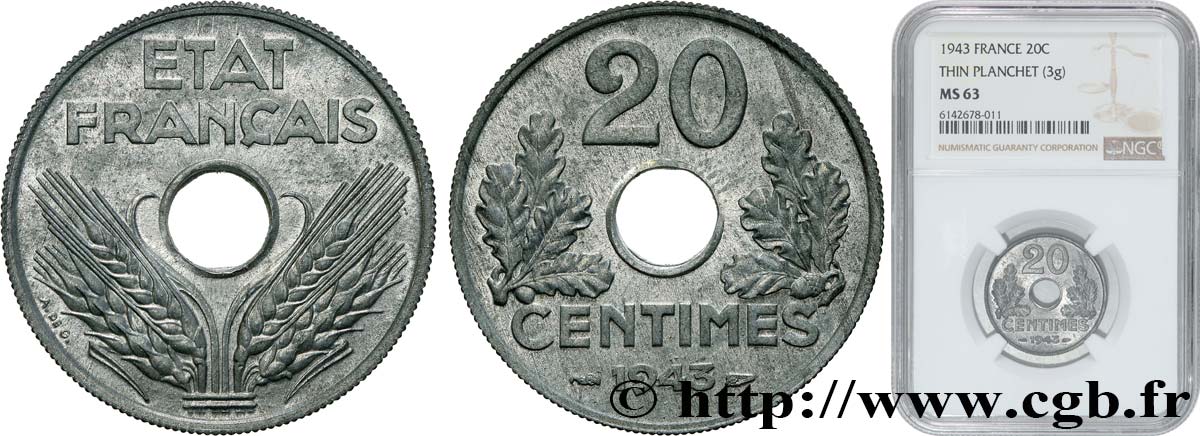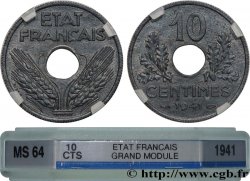Live auction - fmd_679066 - Pré-série sans le mot ESSAI de 20 centimes État français, légère, poids léger (2,88 g) 1943 F.153A/1 var.
Чтобы принять участие в торгах, вы должны войти в систему и стать подтвержденным участником аукциона. Войдите, чтобы сделать ставку. Ваш аккаунт будет подтвержден в течение 48 часов. Не ждите до закрытия торгов, чтобы зарегистрироваться.Сделав ставку на данный товар, вы вступаете в юридическое соглашение на покупку выбранного товара и нажатием кнопки «Сделать ставку» подтверждаете принятие вами условий интернет-аукционов cgb.fr.
Ставка может бить сделана только в полном эквиваленте евро. Торги закроются согласно времени, указанному в описании товара, все ставки, сделанные после закрытия торгов, учитываться не будут. Не следует откладывать предложение вашей ставки до последнего момента, так как система может не успеть обработать вашу заявку, и ваша ставка не будет принята. Более детальную информацию вы найдёте здесь: FAQ по интернет-аукционам.
Все ставки победителей подлежат комиссии 18%.
Все ставки победителей подлежат комиссии 18%.
| Оценить : | 200 € |
| Цена : | 116 € |
| Максимальная предлагаемая цена : | 200 € |
| Конец торгов : | 05 September 2023 18:53:21 |
| Участников : | 3 Участников |
Тип Pré-série sans le mot ESSAI de 20 centimes État français, légère, poids léger (2,88 g)
Дата: 1943
Количество отчеканенных монет: ---
Металл: zinc
Диаметр: 24 mm
Ориентация осей монеты: 6 h.
Вес: 2,88 g.
Век: cannelures fines
Редкость: R3
Slab

NGC : MS63
Комментарии о состоянии
Sous coque NGC MS63, Thin Planchet
Ссылки в каталоге: :
Происхождение:
Cet exemplaire provient de la Collection Michel
Лицевая сторона
Аверс: легенда: ETAT FRANÇAIS.
Аверс: описание: Au-dessus d'épis posés sur un cartouche ; trou de perforation.
Обратная сторона
Реверс: легенда: 20/ CENTIMES/ 1943.
Реверс: Описание: Entre deux branches de chêne.
Комментарий
Toutes les 20 centimes État français contenues dans la Collection Michel ont pour point commun d’avoir une masse comprise aux alentours de 2.80 g. Par un effet du hasard (qui n'en est pas un) les exemplaires de la Collection PIERRE se situent à 3 g comme par exemple pour l'exemplaire suivant : https://www.cgb.fr/20-centimes-etat-francais-frappe-courante-1943-paris-f-153a-1-spl,v30_1159,a.html.
L'explication concernant les exemplaires de 2,8 g et de 3 g se trouve dans les archives de La Monnaie de Paris et à la page 832 de l'ouvrage “LE FRANC LES MONNAIES, LES ARCHIVES 2019” de Philippe Théret, le PV associé du 19 JUIN 1943 si situant en bas de page. L'alliage utilisé pour la réalisation des frappes est un zinc alu et il est précisé que les coins courants ont été utilisés (absence du mot essai). Les frappes ont donc été réalisées les 19 et 22 Juin 1943 sous la forme d'essais industriels (définition exacte d'une pré-série) sans le mot essai.
Le tirage réel est indiqué sur le PV:
- 3 g : 19 502 unités
- 2,8 g : 21 363 unités
Le modèle de 2,8 g n'ayant pas été retenu, l'ensemble du tirage a été cisaillé sauf 40 exemplaires et par conséquent un indice de rareté R3 est bien mérité pour l'ensemble des survivants. Le modèle de 3 g est donc de fait plus commun, la pré-série impossible à identifier par rapport au tirage normal qui a suivi.
Il est à noter que l'exemplaire actuellement en vente est lourd (2,88 g) pour un modèle 2,8 g mais la tolérance est large pour ce type (plus ou moins 5%) ce qui donne un modèle très léger jusqu'à 2,94 g. Le modèle léger de 3 g peut descendre jusqu'à 2,85 g. Ainsi le doute peut être permis pour cet exemplaire mais l'appartenance à la collection MICHEL peut permettre de le lever.
All the 20 centime French State coins contained in the Michel Collection have in common a mass of around 2. 80 g. By chance (which is not one) the examples of the PIERRE Collection are at 3 g as for example for the following example: https://www. cgb. fr/20-centimes-state-french-current-minted-1943-paris-f-153a-1-spl,v30_1159,a. html.
The explanation concerning the 2.8 g and 3 g examples can be found in the archives of La Monnaie de Paris and on page 832 of the work “LE FRANC LES MONNAIES, LES ARCHIVES 2019” by Philippe Théret, the associated PV of June 19, 1943 is located at the bottom of the page. The alloy used for the production of the strikes is zinc aluminum and it is specified that the standard dies were used (absence of the word test). The strikes were therefore carried out on June 19 and 22, 1943 in the form of industrial tests (exact definition of a pre-series) without the word test.
The actual mintage is indicated on the PV: - 3 g: 19,502 units - 2.8 g: 21,363 units The 2.8 g model not having been retained, the entire mintage was sheared except for 40 examples and consequently a rarity index R3 is well deserved for all the survivors. The 3g model is therefore in fact more common, the pre-series impossible to identify compared to the normal print run that followed.
It should be noted that the example currently on sale is heavy (2.88 g) for a 2.8 g model but the tolerance is wide for this type (plus or minus 5%) which gives a very light model up to 2.94 g. The lightweight 3g model can drop down to 2.85g. So doubt may be allowed for this example but the fact that it belongs to the MICHEL collection can help to remove it.
L'explication concernant les exemplaires de 2,8 g et de 3 g se trouve dans les archives de La Monnaie de Paris et à la page 832 de l'ouvrage “LE FRANC LES MONNAIES, LES ARCHIVES 2019” de Philippe Théret, le PV associé du 19 JUIN 1943 si situant en bas de page. L'alliage utilisé pour la réalisation des frappes est un zinc alu et il est précisé que les coins courants ont été utilisés (absence du mot essai). Les frappes ont donc été réalisées les 19 et 22 Juin 1943 sous la forme d'essais industriels (définition exacte d'une pré-série) sans le mot essai.
Le tirage réel est indiqué sur le PV:
- 3 g : 19 502 unités
- 2,8 g : 21 363 unités
Le modèle de 2,8 g n'ayant pas été retenu, l'ensemble du tirage a été cisaillé sauf 40 exemplaires et par conséquent un indice de rareté R3 est bien mérité pour l'ensemble des survivants. Le modèle de 3 g est donc de fait plus commun, la pré-série impossible à identifier par rapport au tirage normal qui a suivi.
Il est à noter que l'exemplaire actuellement en vente est lourd (2,88 g) pour un modèle 2,8 g mais la tolérance est large pour ce type (plus ou moins 5%) ce qui donne un modèle très léger jusqu'à 2,94 g. Le modèle léger de 3 g peut descendre jusqu'à 2,85 g. Ainsi le doute peut être permis pour cet exemplaire mais l'appartenance à la collection MICHEL peut permettre de le lever.
All the 20 centime French State coins contained in the Michel Collection have in common a mass of around 2. 80 g. By chance (which is not one) the examples of the PIERRE Collection are at 3 g as for example for the following example: https://www. cgb. fr/20-centimes-state-french-current-minted-1943-paris-f-153a-1-spl,v30_1159,a. html.
The explanation concerning the 2.8 g and 3 g examples can be found in the archives of La Monnaie de Paris and on page 832 of the work “LE FRANC LES MONNAIES, LES ARCHIVES 2019” by Philippe Théret, the associated PV of June 19, 1943 is located at the bottom of the page. The alloy used for the production of the strikes is zinc aluminum and it is specified that the standard dies were used (absence of the word test). The strikes were therefore carried out on June 19 and 22, 1943 in the form of industrial tests (exact definition of a pre-series) without the word test.
The actual mintage is indicated on the PV: - 3 g: 19,502 units - 2.8 g: 21,363 units The 2.8 g model not having been retained, the entire mintage was sheared except for 40 examples and consequently a rarity index R3 is well deserved for all the survivors. The 3g model is therefore in fact more common, the pre-series impossible to identify compared to the normal print run that followed.
It should be noted that the example currently on sale is heavy (2.88 g) for a 2.8 g model but the tolerance is wide for this type (plus or minus 5%) which gives a very light model up to 2.94 g. The lightweight 3g model can drop down to 2.85g. So doubt may be allowed for this example but the fact that it belongs to the MICHEL collection can help to remove it.








 Cообщить об ошибке
Cообщить об ошибке Распечатать страницу
Распечатать страницу Отправить мой выбор
Отправить мой выбор Задать вопрос
Задать вопрос Consign / sell
Consign / sell
 Информация
Информация









